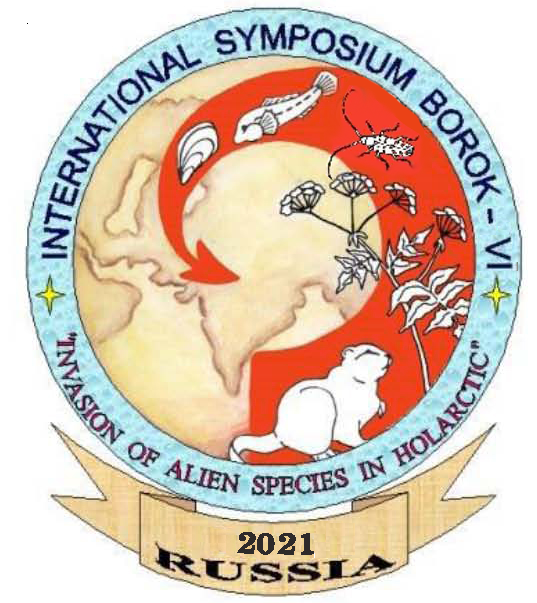 Uglich is one of the oldest and most fascinating towns on the Volga River. It was first documented in 937. In 1328, Moscow Prince Ivan Kalita acquired city territories and it became a part of Moscovia. Uglich reached ultimate prosperity during the reign of Prince Andrew the Great (1446-1493). At that period monasteries were engaged in work on chronicles, correspondence and books design. In other words, the city was a real cultural capital. On May 15, 1591, the most important event in the history of Uglich happened when the son of Ivan the Terrible, Tsarevich Dmitry, was found dead with his throat cut in the palace courtyard. This event was reflected in the coat of arms assigned to Uglich in 1730, in the catch phrase “and bloody boys in the eyes”, and in the Church-monument inside the Uglich Kremlin. At the end of the XIX century the city experienced cultural bloom giving rise to foundation of the museum of national antiquities, the public library and theater community. Uglich started to be visited by tourists and even got on the pages of the first tourist guidebooks. In 1935-1940, near the town, Uglich hydroelectric power station was built that became one of the first power plants of the Volga cascade. At that period several factories appeared in the town. Among them was a factory of technical stones, afterwards it became a famous watch factory "Chaika". In the 1930s, Uglich was called a "cheese capital" of Russia due to foundation of Research Institute of Butter and Cheese. The remained monasteries, churches and buildings were restored in the 1950-1980-s that made Uglich more attractive for tourists.
Uglich is one of the oldest and most fascinating towns on the Volga River. It was first documented in 937. In 1328, Moscow Prince Ivan Kalita acquired city territories and it became a part of Moscovia. Uglich reached ultimate prosperity during the reign of Prince Andrew the Great (1446-1493). At that period monasteries were engaged in work on chronicles, correspondence and books design. In other words, the city was a real cultural capital. On May 15, 1591, the most important event in the history of Uglich happened when the son of Ivan the Terrible, Tsarevich Dmitry, was found dead with his throat cut in the palace courtyard. This event was reflected in the coat of arms assigned to Uglich in 1730, in the catch phrase “and bloody boys in the eyes”, and in the Church-monument inside the Uglich Kremlin. At the end of the XIX century the city experienced cultural bloom giving rise to foundation of the museum of national antiquities, the public library and theater community. Uglich started to be visited by tourists and even got on the pages of the first tourist guidebooks. In 1935-1940, near the town, Uglich hydroelectric power station was built that became one of the first power plants of the Volga cascade. At that period several factories appeared in the town. Among them was a factory of technical stones, afterwards it became a famous watch factory "Chaika". In the 1930s, Uglich was called a "cheese capital" of Russia due to foundation of Research Institute of Butter and Cheese. The remained monasteries, churches and buildings were restored in the 1950-1980-s that made Uglich more attractive for tourists.
Attractions:
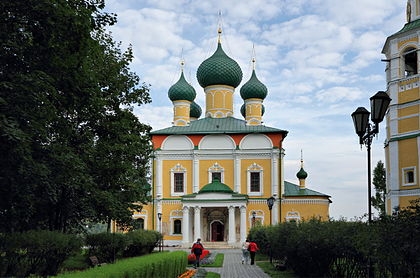
Uglich Kremlin
The very first fortress that preceded the Kremlin of Prince Andrew the Great is known to be rebuilt in the XV century. The Kremlin of Prince Andrew the Great stood up until the end of the XVIII century. It had chopped wooden walls, ten towers and three gates. Part of this complex, albeit in modified form, can be seen in our time. Nicholas Bridge (1808) leads to the Kremlin, that is the only thing left from the Nicholas baroque church of the XVIII century standing here until 1917. The Kremlin itself was not preserved in Uglich, but its former territory, was transformed into the part of the park where several remarkable monuments are found.
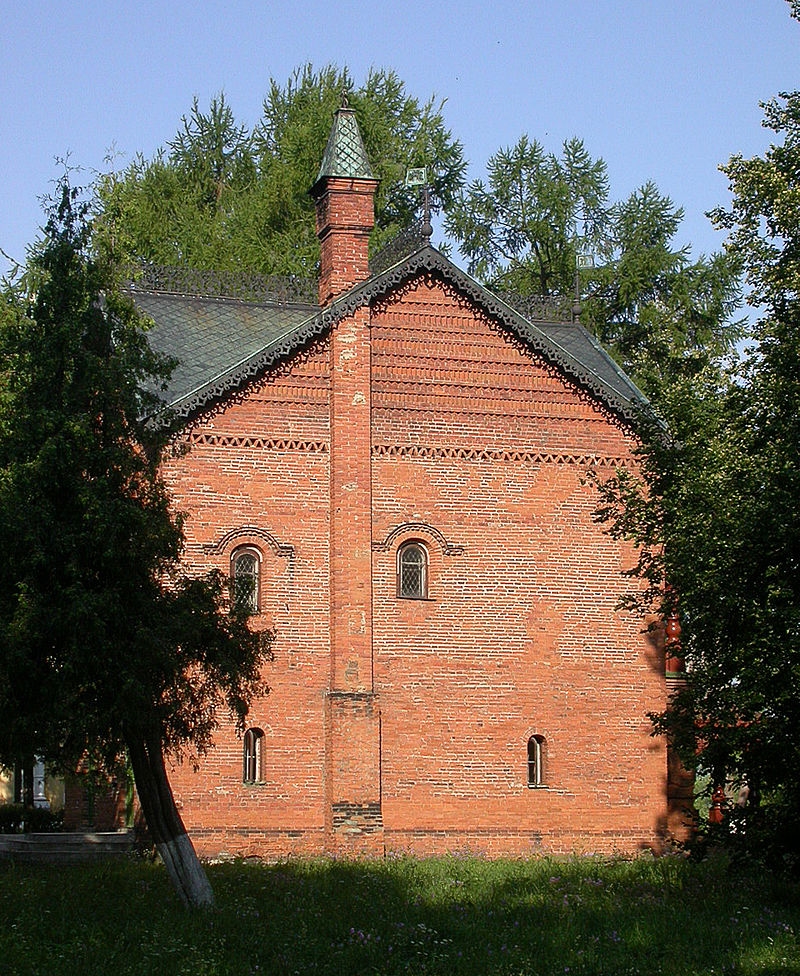
Chambers of Tsarevich Dmitry (XV century)
Chambers of Dmitry were not his residence but his name stuck to them due to the fact that the oldest building in the city happened to be a "witness" of the tragedy. This red-brick building is all that has remained from the palace complex of Andrew the Great. The Chambers are the oldest residential building not only in Uglich but also in Central Russia. Their cover and specific ornament evidenced that Novgorod masters participated in their construction. New porch and decorative lattice on the roof appeared during the restoration in 1892. Inside is found Uglich museum which was opened in 1892 on the 300th anniversary of the death of Prince. A very rich collection of the museum includes icons of XVII-XIX centuries taken from the walls of the fortress, guns of early XVII century and the coats of arms of craft guilds of the XVIII century.
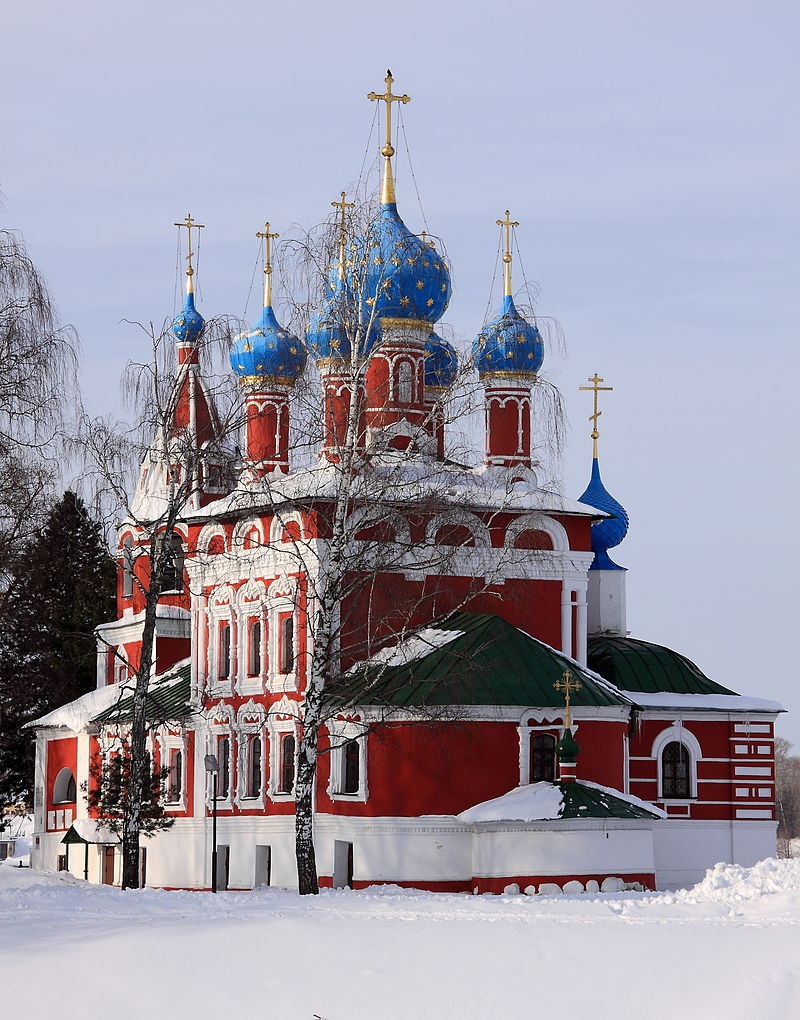
Church of Dmitry on the Blood:
In 1692, a wooden chapel was replaced by a stone church, its altar part was built exactly over the spot of Prince death. The church is located on the picturesque banks of the Volga and it is the facade and symbol of the city. It has the décor and traditional architectural style of the XVII century. Its interior is much more exotic. The walls and vaults of the pillarless church were painted in the XVIII century, the western part of the composition describes the fateful day in the life of Prince in the spirit of secular painting. The most incredible are the refectory paintings, performed by P. Khlebnikov in 1788. They strike us by realistic depiction of naked bodies unusual for church illustrating the biblical scenes. Large carved iconostasis of the church was made in 1867, a small iconostasis with dark icons is contemporary of the church. Among the relics kept in the church are the alarm bell that rang the news of Dimitriy's death. The bell was punished for this: they cut its "tongue", flogged with whips, and afterwards it was "exiled" to Siberia for three centuries. The bell settled in Tobolsk Kremlin, later on it was rehabilitated but it returned to Uglich only in 1892.
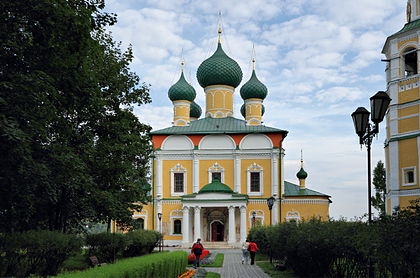
Transfiguration Cathedral of the Kremlin
The present building of the Transfiguration Cathedral was erected in 1706 by decree of Peter the Great in the place of ruined church of the XV century. Its style is transitional from the traditional architecture of the XVII century to Naryshkin Baroque which is clearly seen in the Bell Tower of 1730, architecture of which was long a standard for the later bell towers of the city. The inner space of the Cathedral is found under a lightweight vault painted by Timofey Medvedev in 1809 – 1811. Church fresco "Transformation" is a copy of the Vatican work by Raphael. Grand six-stepped iconostasis was made in 1853 in the spirit of Naryshkin Baroque, it consists mainly of the icons of the XVIII century. In the north aisle is an exhibition of works of applied art of the XV-XVIII centuries and a collection of 60 icons of different schools of Russian iconography including that from Uglich. Among the most valuable specimens in the collection are icons of "Leontief rank" by Dionysius from the Cathedral of the Intercession Monastery, Moscow Nicholas the Wonderworker of the XVI century and Rostov Nikola Mozhajski of the XVI century. For large groups of tourists, a singing ensemble performs an ancient sacred music in the cathedral.
Epiphany Cathedral
Cathedral was erected in the first quarter of the XIX century. It lost its domes due to resemblance to a secular building. In winter, it was used for church service instead of summer Transfiguration Cathedral. Inside is held exhibition of paintings of the XVIII – XX centuries with the noble, merchant and salon portraits. Among them are works by I.V. Tarhanov, Uglich face painter of the XIX century. In this building is found a ticket office of the Kremlin museums.
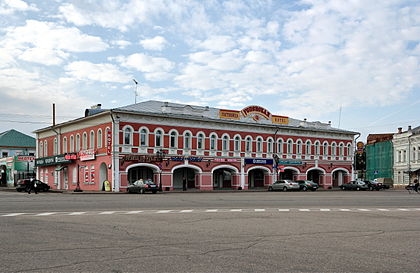
Assumption Square
Assumption Square is the central square of the city which was called after the name of Assumption Church destroyed in 1930's. In the Middle Ages, there was a market there and it acquired the contemporary view after the reconstruction of the XIX century. Before the Fire of 1921, the square was surrounded by lines of shopping malls and public buildings. There were four churches in the square three of which were demolished during the Soviet power.
Chapel-Monument to Defenders of the Fatherland at all times
This small chapel was set in the square in 2004. It has a bell shape and it is topped with a small cupola. Nearby is the alley with plaques dedicated to the defenders of the Fatherland.
House of merchants the Evreinovs
A representative two-storey building of late XIX – early XX century in eclectic style. It belonged to the local patrons famous for their charity and various activities in the field of education. Among their accomplishments are a creation of the city museum, the opening of a public library, the organization of a local theater community. In the 1890s, the house hosted performances of the local troupe headed by tax Inspector M.P. Chekhov, a brother of A.P. Chekhov, a famous journalist, theater critic and publisher.
Museums
Historical-Architectural and Art Museum in the Kremlin
One of the oldest museums in the country was opened in 1892 in the presence of the imperial family.
Central Museum of History of Russian hydropower industry.
Hydroelectric power station is not only an engineering construction but it is also an architectural monument. It was built by prisoners in 1935 – 1940 and it was in the second place in power after Dnieper Hydroelectric Station in the Soviet Union.
Museum of Myths and Superstitions of the Russian people
It is not really a museum but rather a small creative workshop with wax figures of various fairy-tale characters. Here they will tell us where Baba Yaga comes from and why it is commonly accepted to spit over your shoulder or knocking on wood not to put the evil eye on ourselves.
Museum "Russian vodka Library"
The reason why such museum was founded in Uglich was the fact that "vodka king", the well-known businessman P.A. Smirnov was born in these vicinities. The exhibition tells about the history of the production and consumption traditions of this so-called drink.
Museum of Prison Art
Museum is private and it is the only such exhibition in Russia. It includes the subjects that are made by Prisoners from scrap materials including figurines of wood and ... bread.
Historical Museum of Uglich
The oldest private museum of the city is located in a pretty wooden house with a mezzanine in a quiet street. Part of the museum exhibition is outdoors which includes household items, a symbolic monument to Afanasy Nikitin who once visited Uglich, copies of the towers of Uglich Kremlin and that of the wooden church of the XVII century. You can listen to the ensemble "Uglich Bells" there.
Museum of Work Horse (a subdivision of the Museum of Myths and Superstitions of the Russian people)
Guided tours and entertainment programs for children and adults provide an opportunity to visually examine the pre-revolutionary life of the peasants.
Guide to Uglich (History, Getting there, Attractions, Shopping, Food, Where to stay, etc.) - https://ru.wikivoyage.org/wiki/Óãëè÷
City plan (from the encyclopedia "Cities of Russia") -
http://www.towns.ru/towns/uglich.html
Photos
- via Google search
|
